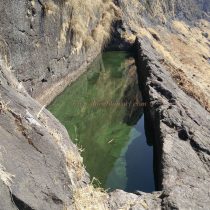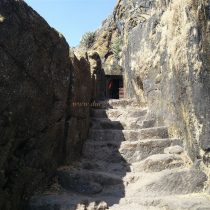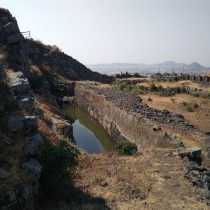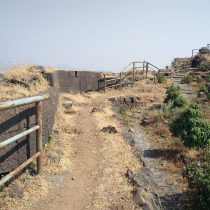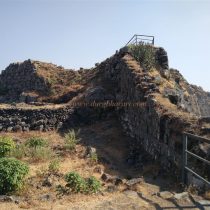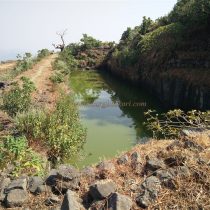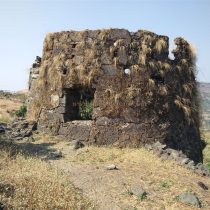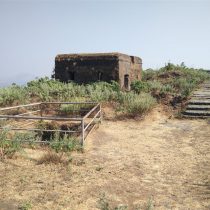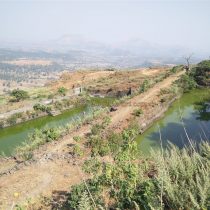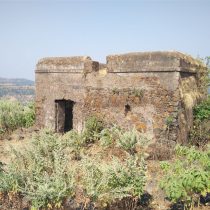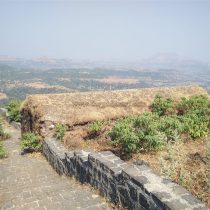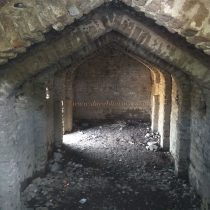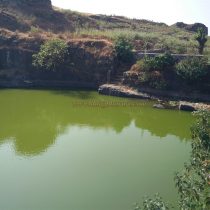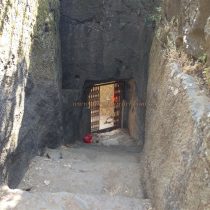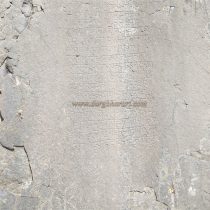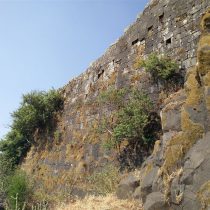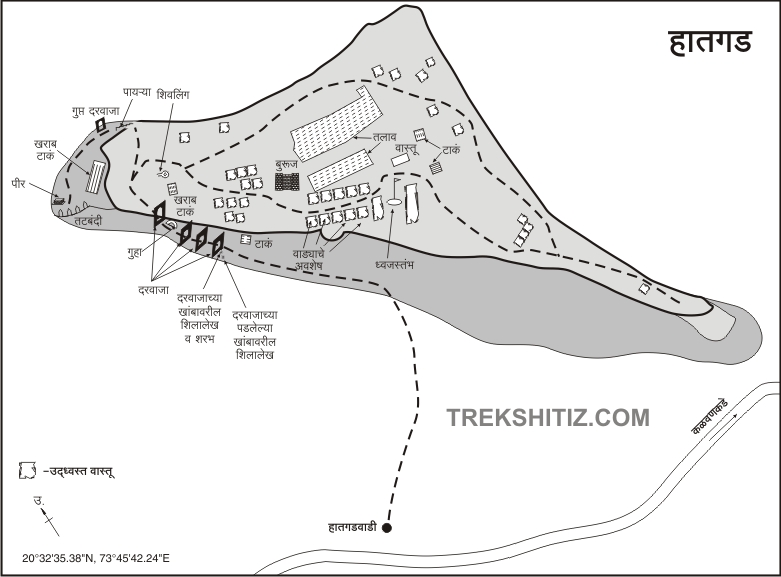HATGAD
TYPE : HILL FORT
DISTRICT : NASHIK
HEIGHT : 3248 FEET
GRADE : EASY
Maharashtra is known as the land of forts. Each fort here has its own identity. Some of these forts are famous for their inaccessibility, some forts are famous for their history and some forts are famous for their architecture. Hatgad fort, located near Saputara in Surgana taluka of Nashik district, is famous for having the largest inscription on the fort in Maharashtra. To reach Hatgad, first, reach Nashik. On Nashik-Saputara highway, at a distance of 74 km from Nashik via Wani and a distance of 6 km from Saputara, there is a fork called Borgaon. From here one road leads to Surgana and the other to Saputara. Hatgadwadi is a village at the base of the fort at a distance of 4 km from Borgaon on the road to Saputara. There are steps to reach the fort from the village and you can go directly to the gate of the fort by paying the forest department fee for a private vehicle.
...
Walking from the village to the fort, you can see some old remains in the village. It features Gangaji More's Samadhi, a limestone mansion, an arched building with horse stables, and a small lake built of wrought stone. Apart from this, if you visit the village, you will see some signs of fortifications around the village. Half an hour is enough to reach the door from the base. At the end of the driveway, there is a green water cistern carved in the rock at the top right of the first door as you walk up the steps towards the door. There is a Maruti idol carved in the rock and a small cave carved in the rock is seen at the front of the road. Seeing this, we reach the first ruined gate of the fort. For entering the fort we have to be cross such four gates This door and the next two doors are facing west and the fourth door is facing north. This gate is built on the right side of the cliff and the left side of the bastion. The arch of this door has collapsed and only the pillars remain. On its left pillar, there is a sculpture of a sharbha holding an elephant in his foot and there is also a Marathi inscription over here. On the right side, there is another inscription that is partially broken. Both these inscriptions are in Devanagari and their letters are fainting over time. A few feet from here, after crossing the second ruined gate of the fort, a few steps can be seen in the ramparts on the left. There is some plain surface after you climb these steps. At the end of this surface is a small bastion. When you come down from this bastion and go 10-12 steps further, you can see 16 lines of Marathi language inscription carved in Devanagari script on the right side of the fort. This inscription is engraved on Shalivahan Shak 1469 i.e. Ekadashi in the month of Ashadh in the year 1547. In this inscription which is about five hundred years old, it is mentioned that Bahiramsen, the son of King Mahadev of the Bagul dynasty, besieged and conquered Hatgad fort which was in the possession of Nizam Shah. Since this inscription is on the outer side of the fort and its exact location is not known, many people cannot see this inscription. After seeing the inscription, come back to the door and start climbing the fort. A little further on through the second door, we enter through the third door in a tunnel carved in the rock. Looking at the high bastion next to this door and the notch in the cliff, the passage through this door seems to be completely blocked. On the right side of the doorway, a huge cave is carved in three stages and it has three dry water cisterns. This place should be a place to stay for the soldiers. The whole path from the third door to the fourth door is carved in stone. The idol of Ganesha is carved on the right side and the idol of Hanuman is carved on the left side. From here we climb 20-25 steps carved in the rock and come in front of the fourth door. The fourth door has a grille door and is closed after 6 pm. After climbing a few steps carved into the rock through this door, you enter the fort. The height of the fort is 3280 feet above sea level and the fort is spread over an area of 8 acres from east to west. When you reach the top, you can see the large fortified ramparts of the fort in front of you. From the place you entered, the fort is divided into two parts on the right and left sides. First of all, you should see the small part of the fort on the left side. The barrages in the ramparts catch your eye. Going down the front road and turning left, we reach the bastion from the ramparts. On this bastion is the recently built tomb of Pir. To the right of the bastion is a high wall of ramparts and in front is a large rectangular cistern filled with water but the water in it is not drinkable. This bastion is built on one of the trunks of the fort and the trunk is separated from the fort by a notch so that it cannot be reached from the lower side. Coming to the fort by road, you can see a door at the bottom of the bastion but you can't see the way to the door from the top. This route may have been lost over time. After exploring the small left side of the fort, come back to the door and go towards the right side. There are a large number of architectural remains in this area and all these constructions are influenced by the Mughal style. At the beginning of the road, on the left side, there is a Shivling carved in the rock on the ground, next to it, there are cisterns extinguished with soil, and then there is another water cistern on the right side. Going further from here, on the left side, you can see around the building like a bastion. Looking at the limestone plaster on the inside of the building and the mud pipes in it, the building was used to bring water from the lake below and circulate it around the fort by air pressure. In front of these buildings, on the slope, you can see two large lakes of water carved one below the other. In the middle of the lake, a pillar has been erected to measure the water level and steps have been constructed at two places to descend into the lake. When you see the cisterns and proceed further, you can see the demolished walls of a building. Inside the building, there is a fountain in the tank. Here, there is a structure with a semicircular roof and a square-shaped deep tank in front of this structure. This structure is a bathroom and such a well-maintained bathroom cannot be seen on any fort. Steam vents on the roof of the bathroom, as well as stoves for hot water outside the walls, water taps, indoor water cistern, and water management, are all worth the visit. Looking at all the remains here, there might have been a palace over here. There are a large number of structures in this area. When you come to see the bathroom, you will see a newly erected flagpole on the right side of the wall and an old structure on the left side. This old structure is the barn of the fort where all the food grains are stored. There are many arches inside of this structure and there are windows in the wall towards the east and west. There is a large water cistern next to the barn and two more cisterns can be seen in the area next to it. There are many water cisterns on the fort, although none of them consists of potable water. After seeing this, come back to the flagpole. The path leading from the flagpole leads to the right end of the fort. Except for a quadrangle structure, no remains can be seen on this plain narrow part of the fort. The entire fort is surrounded by stone ramparts and the forest department has installed an iron fence on these ramparts. From this end of the fort, one can see the entire path leading to the fort. From here, after seeing the ramparts on the left and the bastions on it, your fort round is completed. It takes 1 hour to walk around the entire fort. From the fort, one can see the distant region of Saputara as well as the Salher-Salota forts. Although there are not many records of this fort in history, the history of the fort dates back to the 13th century. The fort, which has been in existence since the 13th century, was known by various names such as Hastagiri, Holgad, Hatga Durg, and Haddagad. The reign of Bagul kings in Baglan was from 1300 to 1700 AD. In the book Rashtraudhavansham Mahakavyam written by Rudra, the poet of Bagul kings in 1596, it is mentioned that Bagul kings captured Hastagiri fort. Later this fort was recaptured by Nizam Shah from the king of Bagul. Hatgad is mentioned in the list of 58 forts conquered by Nizam Shah in the 16th century, while in Mughal documents this fort is mentioned as Holgad. It is mentioned that on behalf of the Mughals, Syed Abdullah sent his son Hasan Ali to capture the fort. As a symbol of victory after the conquest of the fort, Hasan Ali sent a golden key to the emperor on 9 August 1688. The emperor promoted Hasan Ali to the rank of Khan. During the reign of Shivaji Maharaj, Gangaji aka Gogaji More-Deshmukh was on an expedition in Surgana province when he captured Hatgad fort from Adilshahi fort keeper Shurabkhan in Shak 1586 (1663). Rangrao Audhekar was the fort keeper when the fort belonged to the Marathas. It is said that Supkarna Bhill attacked the fort at that time but when the fort keeper repulsed the attack, it is said that Supkarna Bhilla got angry and fled by setting fire to the foothills of the fort.
© Suresh Nimbalkar

